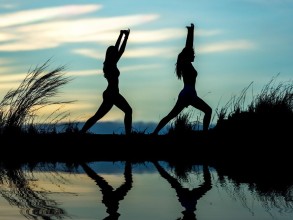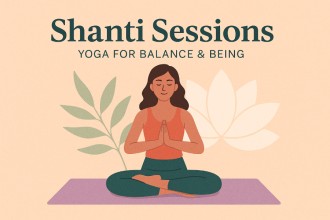Life today moves at an unrelenting pace. Between deadlines, constant notifications and personal responsibilities, it often feels like we are running on empty. In the middle of this chaos, yoga emerges not just as exercise but as a gentle reminder that balance is possible in our bodies, in our minds and in our lives. The art of balance is more than a physical skill of standing steady on one leg; it is a way of living, a practice that aligns us with peace, focus and inner strength.
Balance Beyond the Mat
When most people think of yoga, they picture intricate poses or advanced practitioners twisting into postures that seem almost impossible. But the essence of yoga is not about perfection; it is about connection. The Sanskrit word “yoga” itself means “union,” symbolizing harmony between body, mind and spirit.
Balance in yoga goes far beyond the ability to hold a tree pose or stay steady in warrior III. It extends into how we breathe during stressful times, how we respond to challenges and how we align our thoughts with our actions.
According to the American Osteopathic Association, yoga improves flexibility, muscle strength and respiratory health, but its true benefits come from the calmness and clarity it brings to daily life. In a world filled with distractions, yoga helps us find balance within ourselves.
The Science of Balance
Balancing poses in yoga are not just symbolic; they are deeply beneficial for the body and brain. For instance:
- Improved Focus & Concentration: When practicing balance postures like Vrksasana (Tree Pose), the mind must concentrate on a single point, improving focus. Studies have shown that such practices enhance mental clarity and cognitive performance.
- Strengthens Core & Stability: Balancing requires the activation of the core, strengthening muscles that support posture and prevent injuries.
- Better Nervous System Regulation: Deep breathing and mindful movements stimulate the parasympathetic nervous system, lowering stress hormones like cortisol and restoring calm.
- Emotional Balance: Research from Harvard Health Publishing notes that yoga can reduce symptoms of anxiety and depression, creating more emotional stability.
These scientific insights remind us that balance is not just a poetic idea. It is a measurable state of well-being.
Balance as a Daily Practice
The art of balance in yoga is not achieved overnight. Just as a beginner may wobble and fall during their first tree pose, we often stumble in life when facing uncertainty or pressure. The lesson yoga teaches is that falling is part of learning. Each attempt strengthens not just our muscles but our patience and resilience.
Balancing postures ask us to be present. If your mind wanders to yesterday’s regrets or tomorrow’s worries, you lose steadiness. By drawing attention to the “now,” yoga trains us to remain grounded in the present moment. Over time, this practice translates off the mat into calmer conversations, steadier decision-making and more mindful choices.
Finding Balance in Modern Life
In Nepal and across the world, people are returning to yoga not as a trend but as a necessity. With rising cases of burnout and mental health challenges, the World Health Organization emphasizes the importance of holistic practices like yoga to manage stress and improve quality of life.
Think of balance as a wheel with many spokes: physical health, mental clarity, emotional stability, relationships and purpose. If one spoke is broken, the wheel wobbles. Yoga helps us strengthen each spoke through movement, breathing and reflection so the wheel of life rolls more smoothly.
Practical Ways to Cultivate Balance
- Start Small: A 10-minute yoga practice each morning can shift your energy for the entire day.
- Breathe Consciously: Simple techniques like pranayama (deep breathing) reduce stress instantly.
- Balance Work & Rest: Just as the body needs relaxation between yoga poses, we must give ourselves rest between work demands.
- Mindful Living: Carry the calm from yoga into eating, walking and even speaking. Balance is not found in grand gestures but in everyday moments.
The Emotional Dimension of Balance
Balance is also about self-love. It means forgiving yourself when you cannot achieve everything and appreciating the small victories. Yoga teaches that balance is not rigidity; it is the gentle sway that helps us stay upright even when life pushes us.
Imagine standing in tree pose: your foot presses into your thigh, your gaze fixed, your body gently adjusting with each breath. You are not still like a statue but alive with micro-movements. That is what true balance feels like in life, not static but dynamic, flexible and aware.
The Spiritual Layer
For those who seek deeper meaning, yoga describes balance as union with the self. Ancient texts like the Bhagavad Gita highlight equanimity; the ability to remain steady whether facing joy or sorrow, gain or loss. This spiritual balance frees us from extremes and brings inner peace.
Many practitioners in Nepal incorporate yoga with meditation, chanting and mindfulness rituals, blending tradition with modern life. This integration reminds us that balance is both physical and spiritual, a complete art of living.
A Lifelong Art
Balance is not something we achieve once and keep forever. It is a lifelong practice, much like yoga itself. Some days we stand tall and strong, other days we stumble, but each moment offers an opportunity to return to center.
The art of balance is about harmony, patience and acceptance. It invites us to breathe deeply, to move with awareness and to live with grace. In a world that constantly pulls us in different directions, yoga whispers a timeless truth: balance is already within us, waiting to be nurtured.










